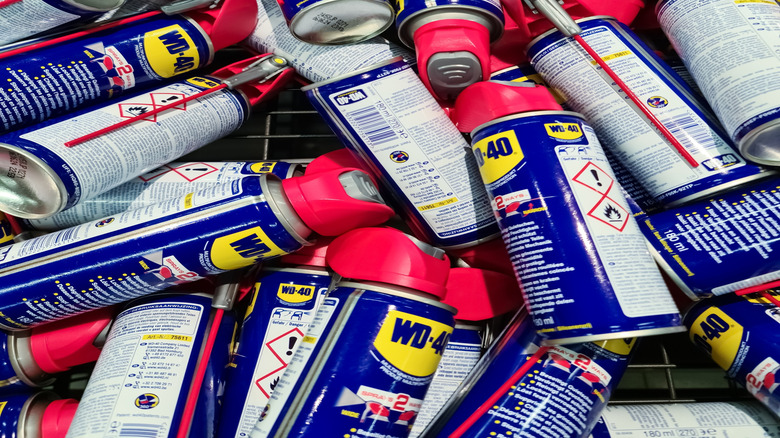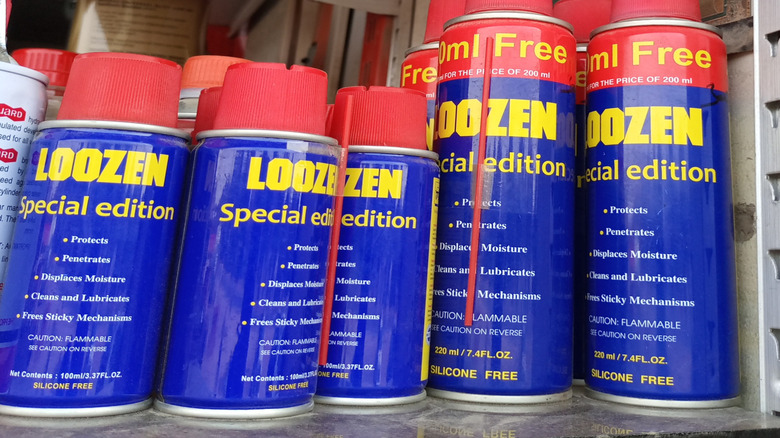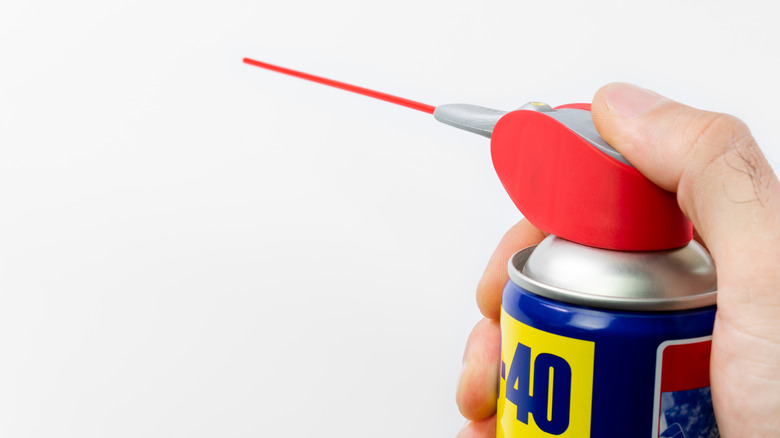How To Spot Counterfeit WD-40 Cans (And What To Do If You Have One)
Every day, we find more and more things that you can do with the humble WD-40. Whether you're a homeowner, driver, or construction professional, there are so many uses for it in your garage and even outside of it. That is, of course, when you're sure that it's a genuine WD-40 product. In 2016, US Customs and Border Protection (CBP) revealed that they were able to successfully intercept thousands of counterfeit WD-40 cans worth around $8,000. Given that millions of crates pass through American ports every day, it's not wild to think of the possibility that more of them were not identified in the past or would be able to go undetected in the years that followed.
Now, it's important to understand that even legitimate WD-40 cans have health risks, especially when they're ingested, come into contact with skin, or are inhaled in large quantities. Counterfeit cans might have more and worse risks. The reason why it's important to know whether the can in your hand is real or fake is because of trust. In many ways, brands aren't just there for marketing purposes; they also hold a degree of accountability for their product performance.
Companies like WD-40 are liable to inform customers about potential side effects associated with the repeated exposure, as well as making sure their products have consistent quality and shelf life. Not to mention, companies like WD-40 have extensively tested not just their products but also the packaging. With a fake product, all of those assurances are lost. If a can that appears to be legit WD-40 causes someone harm, it can reflect badly on WD-40 even if it's fake.
How to spot inauthentic WD-40 cans
Because there are so many types of WD-40 products, it can be difficult to keep track of what is authentic or not simply by appearance. Not to mention, you could also be looking at a potentially older version of its can. Although it doesn't necessarily mean that it's fake, it's not always the best idea to keep using old cans anyway. In the case of WD-40, its products are generally able to perform up to standard for up to five years, but this can even be shorter if it wasn't stored correctly.
In general, one of the easiest ways to confirm whether a can is real or not is by checking it against one that you've used before. When doing so, you can check if things like the size, shape, color, or design of the can are consistent. But if you don't have a guaranteed genuine WD-40 can on-hand, there are some general rules to consider. For example, you can look at the text on it, and check if there are any strange typos, phrasing, or badly printed words. Because WD-40 is a global brand, it would be silly for them not to have hired a proofreader for the packaging of an item that will be mass-produced to thousands of people. That said, not all products that look similar to the WD-40 can are considered fake. In some cases, they may be legitimate products by companies trying to capitalize off WD-40's branding.
What to do if you've bought fake WD-40 cans
First, and foremost, the most obvious thing you should do is to stop using your fake WD-40 entirely. Not only can it damage whatever item you spray it on, but it could also lead to additional problems, especially since its label can be unreliable and not reflective of the actual content. While even real WD-40 is very flammable, it's generally considered safe if you've followed the brand's safety guidelines, storage recommendations, and general care. Similar to other household hazardous waste, the Environmental Protection Agency (EPA) recommends checking your community guidelines for your local disposal options.
If you've bought it via an online retailer that allows third-party sellers, they often have channels wherein you can report the listing. While it can feel like a hassle, this can help prevent other people from falling victim to the same scams. Apart from the possibility of getting a refund, the report can be used as proof when you're filing for disputes with your credit card company. Alternatively, if you bought it from a physical store, you should also take it back along with the official receipt, so they can check the rest of their stocks as well. In the same vein, it's important to take pictures of the product for verification purposes in the future. And if you have the energy for it, you can even file a report with US CBP e-Allegations Online Trade Violation, so they can conduct a more serious investigation.


